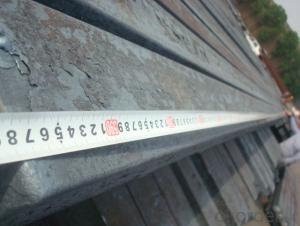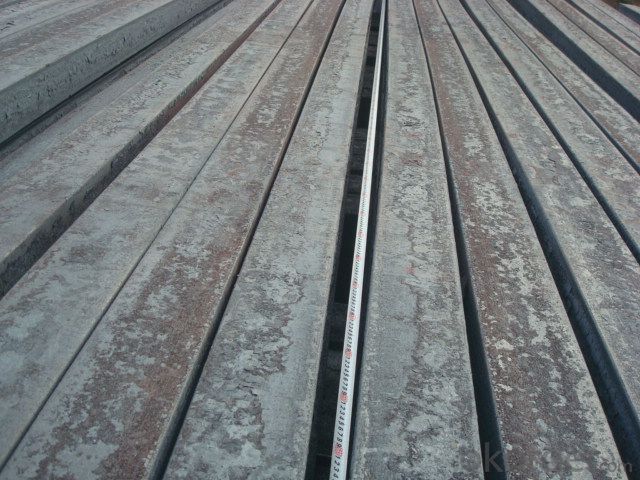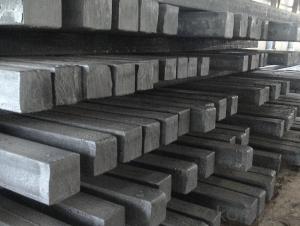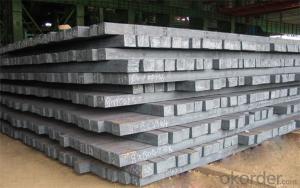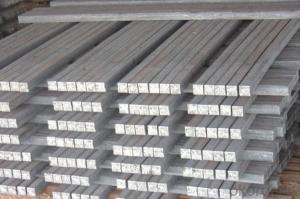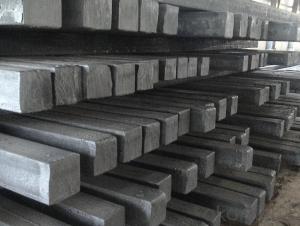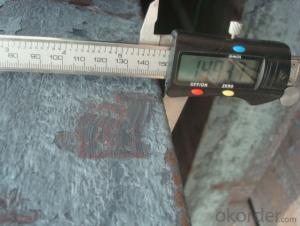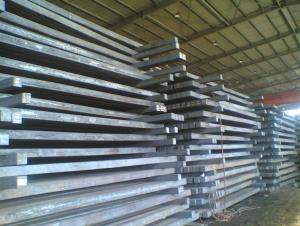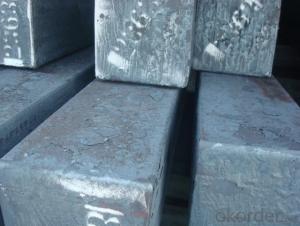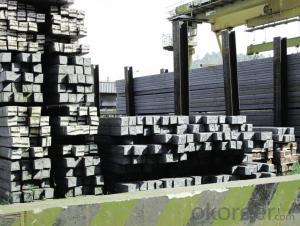Continue Casting Steel Billet/Bloom By Blasting Furnace
- Loading Port:
- Qingdao
- Payment Terms:
- TT OR LC
- Min Order Qty:
- 1000 m.t.
- Supply Capability:
- 10000 m.t./month
OKorder Service Pledge
OKorder Financial Service
You Might Also Like
Continue Casting Steel Billet/Bloom By Blasting Furnace
1.Structure of Continue Casting Steel Billet/Bloom By Blasting Furnace
Continue Casting Steel Billet Manufactured By Blasting Furnace is the raw material of all kinds of steel mill. Billet section of square, round, flat, rectangular and abnormity, etc Several, mainly related to shape of rolled products. Simple rolled section steel, choose cross section of square billet or rectangular billet. rolling The sector products such as flat steel, Angle steel, select the rectangular billet or slab. Had better profiled billet when production beams, channels, and in rolling process Lines and improve the yield. The raw material of round billet is the production of seamless tube.
2.Main Features of Continue Casting Steel Billet/Bloom By Blasting Furnace
Continue Casting Steel Billet Manufactured By Blasting Furnace section size should meet the requirements of rolling deformation and finished product quality, but also roll strength and biting condition of restrictions. General steel Billet section height H. And the roll diameter D The ratio of the ( namely H/D) Should be less than or equal to zero 0.5 . Length of steel billet by finishing temperature, Rolling time and the length of the product Or times ruler. When heated too long accident prone to bump the furnace wall of steel, too short, furnace bottom utilization rate is not high, influence the heating furnace production. For the production Choose a variety of steel and steel billet, should consider the affinities of billet, as far as possible in order to improve the productivity of the roughing mill, simplify the stock management of workshop.
3. Continue Casting Steel Billet/Bloom By Blasting Furnace Images
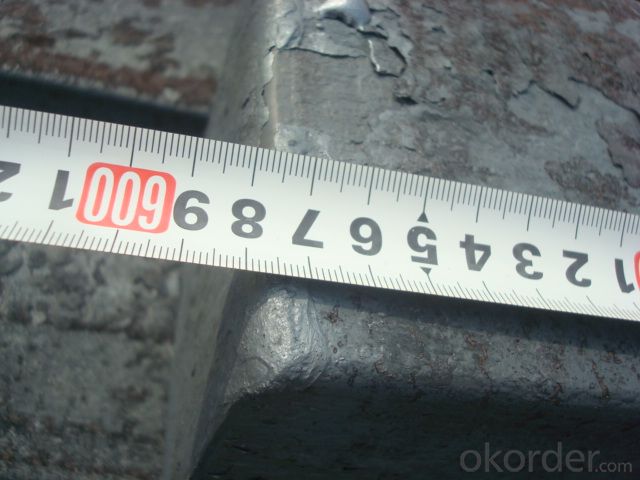
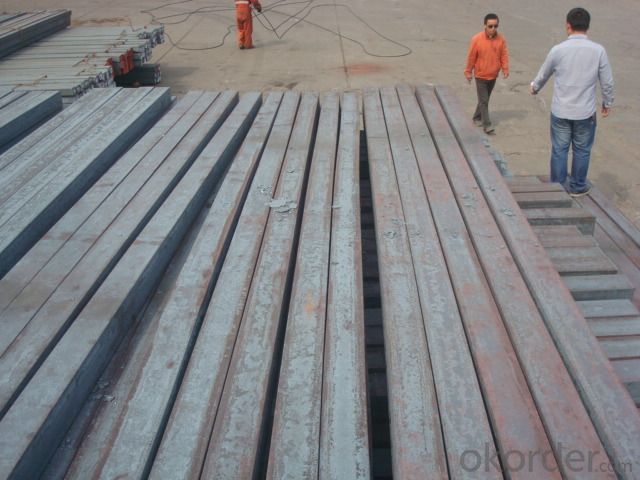
4. Continue Casting Steel Billet/Bloom By Blasting Furnace Specification
Continue Casting Steel Billet Manufactured By Blasting Furnace rolled steel, after processing can be used for mechanical parts, forging parts, processing all kinds of steel, steel Q345B channel steel, wire rod is the role of the billet. Steel billet is used in the production of semi-finished products, generally cannot be used directly for the society. Steel billets and steel are strictly divided into standard, cannot decide to whether the business enterprise of the final product, and according to unified standards to perform the whole society. Typically, billet and the steel is relatively easy to distinguish, but for some steel billet, and have the same specification and same steel purposes (such as rolling tube billet), whether can be used for other industries, whether through steel processing process, whether through a finished product rolling mill processing to distinguish
The classification of the steel According to the quality classification (1)Ordinary steel (P 0.045% or less,S 0.050% or less)POn behalf ofphosphorus,s.On behalf ofsulfur Pands.Are all of the steelThe harmful elements, a leading toHot brittleness, a leading toCold brittle (2)High quality steel (P,s.both0.035% or less) (3)High quality steel (P 0.035% or less,S 0.030% or less) Classified by chemical composition
There are three shapes of the steel billets: square billet, slab, rectangular billet The Chinese billet, rectangular billet is mainly suitable for rolling hot rolled strip, building reinforced bar, Ordinary wire, high speed wire rod and various small profile. Of the slab are mainly used for rolling plate and hot coil sheet.
5.FAQ of Continue Casting Steel Billet/Bloom By Blasting Furnace
We have organized several common questions for our clients,may help you sincerely:
①How is the spec. of the steel billet/ bloom you can supply?
We can supply all kinds of the raw material for our customer according to their requirement.
②Could you give us your garantee letter about the products?
Sure we could.And we can give you the inspecting report as your requirement too. But usually it will be paid by the buyers.
③If the shipment is delayed, how could we settel that?
If the delayed caused by the weather or the dezarster, please understand that we could't be responsible for the delaying, but if by ourselves reasons. We will fully be responsible for that.
- Q: What are the safety precautions in handling steel billets?
- To prevent accidents and injuries, it is necessary to adhere to specific safety precautions when handling steel billets. Some of the essential precautions include: 1. Personal Protective Equipment (PPE): Always wear appropriate PPE, such as safety goggles, gloves, steel-toed boots, and protective clothing. This will safeguard against potential hazards like sharp edges, falling objects, and flying debris. 2. Lifting Techniques: Employ proper lifting techniques, such as bending the knees and using the legs to lift. This will help avoid strains or injuries to the back. If the billets are too heavy to lift manually, utilize mechanical lifting equipment like cranes or forklifts. 3. Secure Storage: Ensure that steel billets are stored securely and stably. This will prevent them from toppling or rolling, which can lead to injuries or damage to equipment and infrastructure. To keep the billets organized and secure, employ suitable storage racks, bins, or pallets. 4. Handling Tools: Safely handle steel billets using appropriate tools such as lifting hooks, clamps, or tongs. Avoid using your hands or body to move or reposition the billets, as this can result in pinching, crushing, or cutting injuries. 5. Clear and Well-Defined Work Area: Maintain a work area around the steel billets that is clear and well-defined. This will prevent tripping hazards. Remove any obstructions or debris that could cause slips, trips, or falls. 6. Communication and Training: Ensure that all personnel involved in handling steel billets receive sufficient training in safe handling procedures and are aware of potential hazards. Establish clear communication channels to coordinate movements and actions, especially when using machinery or working in teams. 7. Inspection and Maintenance: Regularly inspect the condition of the steel billets, lifting equipment, and storage racks to identify any potential safety issues. Promptly address any defects, damages, or signs of wear and tear to prevent accidents. 8. Emergency Procedures: Establish emergency procedures and ensure that all personnel are familiar with them. This includes procedures for handling accidents, injuries, spills, or other emergencies that may occur during the handling of steel billets. By adhering to these safety precautions, the risk of accidents and injuries can be minimized, creating a safer working environment for those involved in handling steel billets.
- Q: What are the different methods of hardness testing for steel billets?
- There are several methods of hardness testing for steel billets, each offering different advantages and levels of accuracy. Some of the most common methods include: 1. Rockwell hardness testing: This is one of the most widely used methods and measures the depth of indentation caused by a specific load on a steel billet's surface. It provides a hardness value based on the depth of penetration, making it convenient and relatively quick to perform. 2. Brinell hardness testing: This method involves indenting a steel billet's surface with a spherical indenter under a specific load. The diameter of the resulting impression is measured to determine the hardness value. Brinell testing is especially useful for large billets or materials with a coarse microstructure. 3. Vickers hardness testing: Vickers testing uses a pyramidal diamond indenter to create an impression on the surface of a steel billet. The diagonal length of the impression is measured, and the hardness value is calculated based on the applied load. Vickers testing is suitable for a wide range of materials, including steel billets. 4. Knoop hardness testing: Similar to Vickers testing, Knoop hardness testing also uses a pyramidal diamond indenter. However, the indentation shape is elongated and narrower, allowing for measurements on smaller or thinner samples. This method is often used for precise and microhardness testing. 5. Leeb hardness testing: Leeb testing is a portable and non-destructive method that uses an impact device to measure the rebound hardness of a steel billet. The device strikes the surface with a small ball and measures the velocity of the rebound, which is then converted into a hardness value. This method is commonly used for on-site or in-field measurements. 6. Ultrasonic hardness testing: This method uses ultrasonic waves to measure the hardness of a steel billet. The waves are transmitted through the material, and the time taken for the waves to travel through the billet is measured. This data is then converted into a hardness value. Ultrasonic testing is non-destructive and suitable for large or thick billets. It is important to note that each hardness testing method has its own limitations and considerations. The choice of method will depend on factors such as the size, shape, and surface condition of the steel billet, as well as the desired accuracy and convenience of the testing process.
- Q: How are steel billets inspected for surface finish?
- Steel billets are typically inspected for surface finish using visual inspection methods, such as the naked eye or with the aid of magnifying devices. The surface is examined for any defects, such as cracks, scratches, pits, or any irregularities that may affect the quality of the steel. Additionally, the billets may also undergo non-destructive testing techniques, such as ultrasonic testing or magnetic particle inspection, to further ensure the absence of any hidden flaws in the surface finish.
- Q: What is the typical production process for steel billets?
- The process of producing steel billets typically involves a series of steps. Initially, raw materials like iron ore, coal, and limestone are acquired. These materials are then processed and converted into iron through a blast furnace or direct reduction method. To eliminate impurities and adjust the composition, the iron is further refined in either a basic oxygen furnace or an electric arc furnace. Once the iron has been refined, it is poured into large rectangular molds known as ingots. These ingots are subsequently heated and rolled into semi-finished products called blooms or slabs. Blooms usually have a square or rectangular shape, whereas slabs are flat and rectangular in form. The next stage is to further process the blooms or slabs into billets. This is achieved by reheating the semi-finished products and passing them through a sequence of rolling mills. The rolling mills exert pressure to shape the metal and decrease its thickness. This process, known as hot rolling, takes place. After hot rolling, the billets are cooled and carefully examined for any defects. They may also undergo additional processes, such as surface treatment or heat treatment, to enhance their properties. Finally, the billets are typically cut into desired lengths and stored before undergoing further processing or being shipped to customers. In conclusion, the production of steel billets involves obtaining raw materials, refining the iron, casting it into semi-finished products, hot rolling, and conducting final inspection and processing. This comprehensive process ensures that the steel billets meet the necessary specifications and quality standards before being utilized in various industries, including construction, automotive, and manufacturing.
- Q: What are the main factors that determine the profitability of steel billets manufacturers?
- There are several key factors that impact the profitability of steel billets manufacturers. These factors can vary depending on market conditions and industry dynamics. However, determining profitability in this sector involves considering certain main factors: 1. Raw material costs: The cost of raw materials, such as iron ore and scrap metal, greatly affects profitability. Fluctuations in these costs can influence the overall cost structure of steel billet production. Manufacturers who have efficient procurement strategies and long-term raw material contracts may have a competitive advantage in managing these costs. 2. Production efficiency: The efficiency of the manufacturing process plays a vital role in profitability. This includes factors like production capacity utilization, energy consumption, labor productivity, and waste management. Manufacturers who can optimize their operations and minimize costs are more likely to achieve higher profitability. 3. Market demand and pricing: The demand for steel billets is influenced by factors like construction activity, infrastructure development, and manufacturing output. Manufacturers who can accurately forecast and meet market demand are better positioned to achieve profitability. Additionally, the ability to negotiate favorable pricing and manage price fluctuations can significantly impact profitability. 4. Competitive landscape: The level of competition within the steel billets manufacturing industry can affect profitability. Manufacturers operating in a highly competitive market may face challenges in maintaining profit margins due to price pressures. Companies that can differentiate themselves through innovation, quality, and customer service may have a better chance of achieving sustainable profitability. 5. Operating costs: In addition to raw material costs, other operating expenses like transportation, energy, maintenance, and overhead costs can impact profitability. Efficient cost management practices, such as implementing lean manufacturing principles and optimizing supply chain logistics, can help reduce operating costs and improve profitability. 6. International trade and tariffs: Steel billets manufacturers are often impacted by international trade dynamics and tariffs. The imposition of tariffs on steel imports or exports can disrupt the market and impact profitability. Manufacturers who can adapt to changes in trade policies and diversify their customer base or sourcing locations may be better positioned to mitigate these risks. 7. Currency exchange rates: Steel billets manufacturers engaged in international trade may be exposed to currency exchange rate fluctuations. These fluctuations can impact the cost of imported raw materials or the competitiveness of exported products. Manufacturers who have effective currency hedging strategies or local production capabilities may be better able to manage these risks and maintain profitability. In conclusion, the profitability of steel billets manufacturers is influenced by various factors, including raw material costs, production efficiency, market demand, competition, operating costs, international trade dynamics, and currency exchange rates. Successful manufacturers in this industry must carefully analyze and manage these factors to achieve sustainable profitability.
- Q: What are the applications of steel billets?
- Steel billets are primarily used as raw material in the production of various steel products such as bars, rods, wire, and seamless tubes. They are also used in the manufacturing of components for automotive, construction, and machinery industries. Additionally, steel billets can be further processed to produce forgings, which are used in heavy machinery and equipment.
- Q: What are the main factors affecting the surface finish of steel billets?
- Several key factors can be attributed to the surface finish of steel billets. Firstly, the quality and cleanliness of the raw materials used in the steelmaking process play a significant role. Surface defects and imperfections can occur if there are impurities or contaminants in the raw materials. Secondly, the manufacturing process's processing parameters directly impact the surface finish. Factors like temperature, speed, and pressure can affect the formation of scale, oxidation, and other surface abnormalities. Excessive scaling can result from high temperatures, while inadequate scale removal can occur due to insufficient temperature control. Furthermore, the surface finish of steel billets is influenced by the type and condition of the equipment used for production. Abrasions, scratches, or other defects in the machinery can transfer onto the billets, affecting their surface quality. Regular maintenance and proper upkeep of the machinery are crucial to ensure a smooth and defect-free surface finish. Moreover, the choice and application of lubricants and coatings during the production process also impact the surface finish. These substances protect the billets from oxidation and reduce friction. However, incorrect application or the use of the wrong lubricant can lead to uneven coating, streaking, or other surface irregularities. Lastly, the handling and storage of steel billets after production can affect their surface finish. Mishandling, improper storage conditions, or exposure to moisture, chemicals, or contaminants can all contribute to surface defects and deterioration. In conclusion, the surface finish of steel billets is influenced by the quality of raw materials, processing parameters, equipment condition, lubricant and coating application, and proper handling and storage. By closely monitoring and optimizing these factors, manufacturers can achieve a high-quality surface finish that meets the desired specifications and requirements.
- Q: How are steel billets used in the manufacturing of rail tracks?
- Steel billets are an essential component in the manufacturing of rail tracks. A billet is a semi-finished piece of steel that is commonly used as a starting material in various metalworking processes. In the case of rail track manufacturing, steel billets are first heated to a high temperature and then passed through a series of rolling mills. During the rolling process, the steel billets are gradually shaped and elongated to form long, narrow sections known as rail blooms. These rail blooms are then further processed and shaped through hot rolling, where they are passed through multiple sets of rollers to achieve the desired dimensions and shape of the rail track. This process helps in improving the mechanical properties of the steel, such as its strength and durability. Once the rail blooms are shaped, they undergo a process called controlled cooling, where they are cooled at a specific rate to optimize their microstructure and properties. This controlled cooling helps in reducing internal stresses and improving the overall quality of the rail tracks. After the controlled cooling process, the rail blooms are further processed through straightening, cutting, and finally, finishing operations. These operations ensure that the rail tracks are straight, have precise dimensions, and meet the required standards and specifications. In summary, steel billets play a crucial role in the manufacturing of rail tracks. They are transformed into rail blooms through a series of rolling processes, and then further processed to produce high-quality rail tracks that are strong, durable, and able to withstand the heavy loads and constant use of railway transportation systems.
- Q: How do steel billets contribute to the aerospace industry?
- Steel billets play a crucial role in the aerospace industry by providing the necessary raw material for manufacturing various components and structures used in aircraft. These billets, which are semi-finished metal forms, are typically produced through a process called continuous casting, where molten steel is poured into a mold to create a solid billet shape. Once the steel billets are formed, they are further processed into different aerospace components through various manufacturing techniques such as forging, machining, and heat treatment. These processes allow the steel billets to be shaped into specific forms, such as engine components, landing gear parts, structural frames, and other critical aerospace components. The use of steel billets in the aerospace industry offers several advantages. Firstly, steel is known for its high strength, durability, and excellent mechanical properties, making it a suitable material for applications where safety and reliability are of utmost importance, such as in the aerospace sector. Steel billets can withstand extreme temperatures, pressure, and stress, making them ideal for critical parts that need to perform under demanding conditions. Additionally, steel billets provide cost-effectiveness and versatility in manufacturing. Steel is widely available, making it a relatively affordable material compared to other metals used in the aerospace industry. Moreover, the ability to shape and process steel billets into various forms and sizes allows for flexibility in designing and producing aerospace components, ensuring they meet the specific requirements and standards of aircraft manufacturers. Another key contribution of steel billets to the aerospace industry is their compatibility with advanced manufacturing technologies. Steel can be easily machined, welded, and joined, enabling the integration of complex features and structures in aerospace components. This compatibility with modern manufacturing techniques allows for the production of lightweight, yet robust, parts, contributing to overall fuel efficiency and improved performance of aircraft. In conclusion, steel billets are vital to the aerospace industry as they provide the necessary raw material for manufacturing critical components and structures used in aircraft. Their high strength, durability, cost-effectiveness, and compatibility with advanced manufacturing technologies make steel billets an essential ingredient in building safe, reliable, and efficient aerospace systems.
- Q: What is the typical elongation of a steel billet?
- The typical elongation of a steel billet can vary depending on several factors such as the specific grade of steel, the manufacturing process, and the intended application. However, in general, the elongation of a steel billet is typically around 20% to 30%. Elongation is a measure of a material's ability to deform or stretch before breaking. It is usually expressed as a percentage and is determined by conducting a tensile test on a sample of the material. During this test, the sample is subjected to gradually increasing tensile forces until it eventually fractures. The amount of elongation is measured by comparing the original length of the sample to its final length at the point of fracture. Steel is known for its high tensile strength, which means it can withstand significant forces without breaking. However, it also exhibits a certain degree of ductility, allowing it to elongate before reaching its breaking point. The typical elongation of a steel billet falls within the range mentioned above, indicating that it can stretch by 20% to 30% of its original length before fracturing. It's important to note that different grades of steel can have varying elongation properties. For example, higher carbon steels tend to have lower elongation values compared to low carbon or mild steels. Additionally, the manufacturing process can also affect the elongation of a steel billet. Processes such as hot rolling or cold drawing can modify the microstructure of the steel, thereby influencing its elongation characteristics. Ultimately, the specific elongation requirements for a steel billet will depend on the intended application. Certain industries, such as construction or automotive, may require steel with higher elongation values to ensure the material can withstand the stresses and strains it will encounter during use. Conversely, other applications may prioritize higher tensile strength over elongation.
Send your message to us
Continue Casting Steel Billet/Bloom By Blasting Furnace
- Loading Port:
- Qingdao
- Payment Terms:
- TT OR LC
- Min Order Qty:
- 1000 m.t.
- Supply Capability:
- 10000 m.t./month
OKorder Service Pledge
OKorder Financial Service
Similar products
Hot products
Hot Searches
Related keywords
